The Brazos Performance Preview: AMD E-350 Benchmarked
by Anand Lal Shimpi on November 16, 2010 12:01 AM ESTMemory and Cache Latencies
The Brazos platform was configured with 4GB of DDR3-1066 memory. The IDF system had memory running at DDR3-1333, however AMD had to decrease clocks presumably to meet validation requirements for final silicon. I measured an 86.9ns trip to main memory, a 3 cycle L1 and a ~22 cycle L2 cache. That's a lower latency memory interface than Atom or Core 2 based processors, but a higher latency L2.
CPU Performance: Better than Atom, 90% of K8 but Slower than Pentium DC
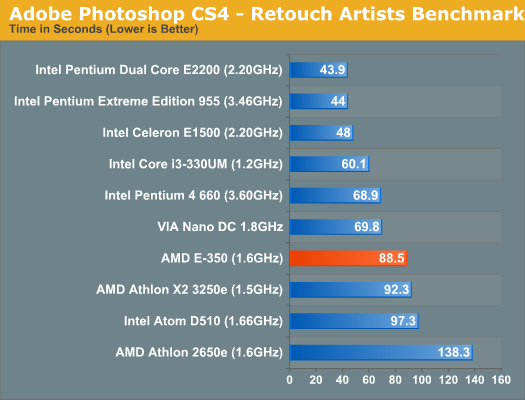
AMD's performance target for Bobcat was 90% of the performance of K8 at the same clock speed and our Photoshop CS4 benchmark shows that AMD can definitely say that it has met that goal. At 1.6GHz the E-350 manages to outperform a pair of K8s running at 1.5GHz in the Athlon X2 3250e. Unfortunately for AMD, Intel's Pentium dual-core running at 2.2GHz is much quicker. Most notebooks in the $400+ range have at least a 2.2GHz Pentium. Even the Atom D510 isn't far behind.
AMD tells me that in general purpose integer tasks, the E-350 should do well and it may even exceed AMD's 90% design target. However in higher IPC workloads, for example many floating point workloads, the E-350 is constrained by its dual issue front end. In these situations, the out of order engine is starved for instructions and much of Bobcat's advantage goes away.

Our x264 HD test has the E-350 performing within 86 - 92% of the Athlon X2 3250e, once again meeting AMD's design targets. Unfortunately, this isn't much faster than an Atom - mostly thanks to Atom's Hyper Threading support. Although not an out of order architecture, Atom gets a healthy efficiency boost by being able to execute instructions from two threads per core. Once again, compared to a 2.2GHz Pentium, the E-350 isn't close. Even VIA's dual core Nano is faster. When it comes to power consumption however, the E-350 can't be touched. I measured max system power consumption at 25.2W while running the x264 encode test. With the exception of the Atom D510, the rest of the desktop platforms here consume much more than that at idle (much less under load).
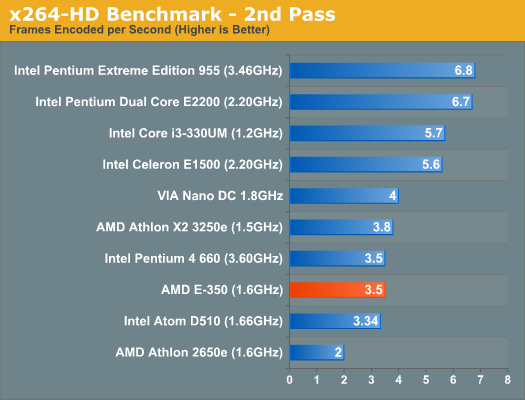
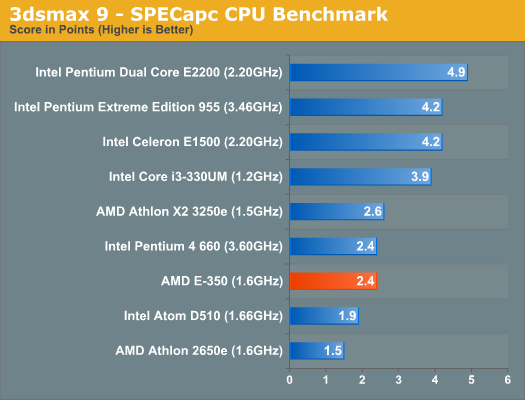
Despite being a offline 3D rendering benchmark, our 3dsmax 9 test does fall in line with expectations. The E-350 delivers 92% of the performance of the Athlon X2 3250e and outperforms the Atom D510 by 26%. Unfortunately for AMD, the Pentium dual-core holds onto a significant performance advantage here. Clock for clock, Bobcat won't be able to do much against anything Core 2 based. The real advantage here will be GPU performance.
Single Threaded Performance
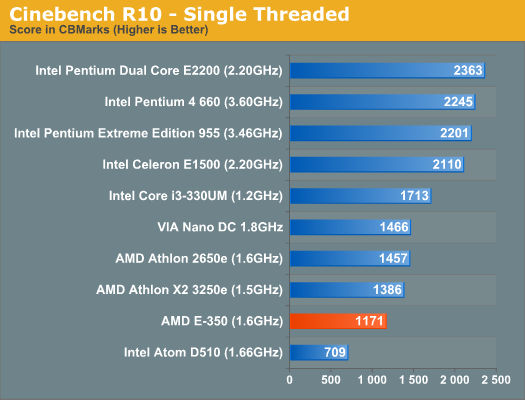
In most of our benchmarks the performance advantage over Atom isn't huge, yet using Brazos is much better than using an Atom based machine. It all boils down to one thing: single threaded performance. Atom can make up for its deficiencies by executing a lot of threads in parallel, but when you're bound by the performance of a single thread the E-350 shines. The E-350 is 65% faster than the Atom D510 in the single threaded Cinebench R10 test. It's this performance advantage that makes the E-350 feel so much quicker than Atom.
The Core i3-330UM manages a 46% performance advantage over the E-350. Even in the ultraportable Arrandale ULV space at lower clocks, AMD still leaves a lot of CPU performance on the table. The advantage here will be cost. A single E-350 is less than 40% of the die area of a Core i3-330UM. You may not get the same CPU performance, but performance per mm^2 is much higher.

In the multithreaded Cinebench test Atom is able to catch up quite a bit, but the E-350 still holds an 11% advantage.
File Compression/Archive Recovery Performance
Our final two CPU tests are both multithreaded and they show the E-350 equaling and falling behind the performance of the 1.5GHz Athlon X2. As we explained earlier, the gap between the E-350 and Atom shrinks as you add more threads to the workload.
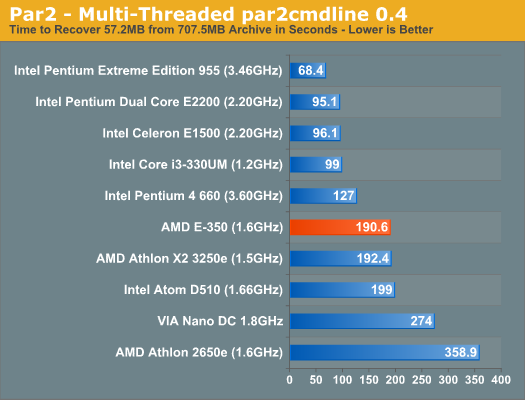
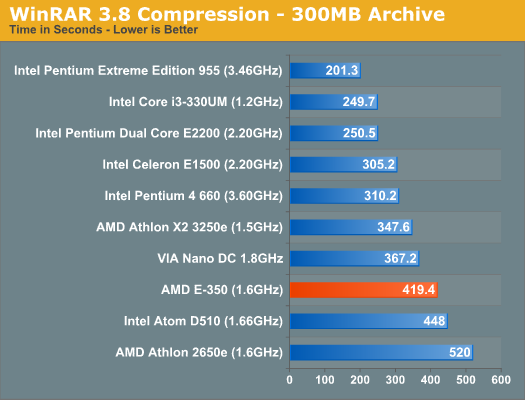










207 Comments
View All Comments
ET - Tuesday, November 16, 2010 - link
I'm not saying it's a bad product, and as I said it should draw the OEM's. What it doesn't do is change the kind of products available. It's not significantly faster, doesn't really allow gaming, it's just another entry point that's not bad. It will power yet another bunch of low cost notebooks that can only be used for everyday tasks. At the netbook side it may be a little more convincing, since it saves the need for an extra chip for video, and benchmarks showed a significantly higher javascript speed compared to an Atom, which matters. But still, there's no wow factor about it.As a consumer I will certainly prefer an AMD netbook with this chip to an Atom based one, it's just that I was hoping for more. From my point of view, the advantage of such a netbook over Atom+Ion:
- Lower price
- Perhaps smoother everyday use (hinted at by the javascript benchmark)
- No artificial hardware limits, far as I know, so I expect to see a "netbook" with 4GB of RAM (or at least upgradeable to that)
- If I'd want to try Direct3D development on it (which I did in the past on similar strength hardware), I'll have the full DX11 feature set, even if at very low speed.
flyck - Tuesday, November 16, 2010 - link
it IS significantly faster. What the benchmarks do not show is single threaded applications. Single threaded is dead slow on Atom. e.g. starting an application/user interfaces all single threaded will feel slugish on Atom and not on Ontario.1Ghz Bobcat equals around 1.6GHz Atom cpu in single threaded applications how is that disappointing for a smaller cpu?
ET - Tuesday, November 16, 2010 - link
> 1Ghz Bobcat equals around 1.6GHz Atom cpu in single threaded applications how is that disappointing for a smaller cpu?Because as a consumer I don't care at all whether the CPU is smaller. I care about performance (and I do care to an extent about characteristics like power consumption and heat, but that's a lesser factor). Being given another CPU which performs like an Atom is disappointing. I didn't want another Atom. I was hoping that AMD for once will be able to take the performance crown, and by a significant margin, and I'm disappointed that it couldn't.
AMDJunkie - Tuesday, November 16, 2010 - link
Also, it should play Crysis. And be $100 cheaper. And use sub-1W power. You know what, knock another $100 off that price. Why isn't it free?Sometimes, I think the big corporations are just holding back, trying to squeeze a buck out of us enthusiasts. There's no difficulty at all making a chip that does everything at this price range, they just don't want to. :(
flibbertigibbet - Tuesday, November 16, 2010 - link
I am very disappointed by Anand's choice of systems to benchmark Zacate against. He himself says it is intended to compete in the ultra-portable, high end netbook, nettop, and low end notebook space. That being the case, I think some of the following systems would have made for a better comparison:- Atom N550 (with and without Ion2)
- AMD Nile (K325/K625 + Radeon 4250)
- Intel 2009 CULV (Celeron SU2300/Pentium SU4100 + Intel G45/ Nvidia Ion)
- Intel 2010 ULV Arrandale + Intel HD
I'm happy he included the VIA Nano DC. I hope OEM's come up with sleek, portable machines matched with high-capacity batteries to match Zacate. Can't wait to see more detailed power consumption and battery numbers.
Anand Lal Shimpi - Tuesday, November 16, 2010 - link
I focused mainly on making sure we had low end notebook coverage ($400 - $500 notebooks will have a ~2.2GHz Pentium DC or Core i3), however I've been running i3-330UM numbers this morning and just updated the gaming performance charts with them - refresh to see the new comparison :)Take care,
Anand
trivik12 - Tuesday, November 16, 2010 - link
it would be interesting to compare bobcat with oaktrail platform. That supposedly has very good idle power consumption(supposedly in ARM league) and better load power consumption compared to current solutions.I am sure intel will release CULV based on Sandy Bridge if there is big enough competition from bobcat. 18V CULV with SB core will make it interesting for sure.
Anyway I am glad to see bobcat destroying atom as intel had little intention of making Atom a decent chip. Hopefully this will make intel do something different with oaktrail and medfield.
antaholics - Tuesday, November 16, 2010 - link
I hope nobody asked this yet, but I noticed that the i3/i5 ULVs were not benchmarked to compare. They're at a slightly higher price bracket ($500-700+), but not something consumers wouldn't consider if they're in the market for a high-end netbook.Thanks!
antaholics - Tuesday, November 16, 2010 - link
and they have similar battery life/TDP as Brazos and Atom, unlike the pentium DC and i3 testedSandmanWN - Tuesday, November 16, 2010 - link
When you buy anything your first metric is money. You don't just arbitrarily decide to consider a higher price bracket. You wouldn't even consider this if you where looking at the 500-700+ price range.